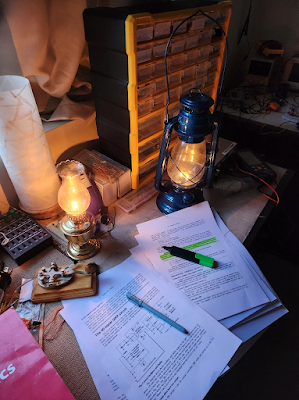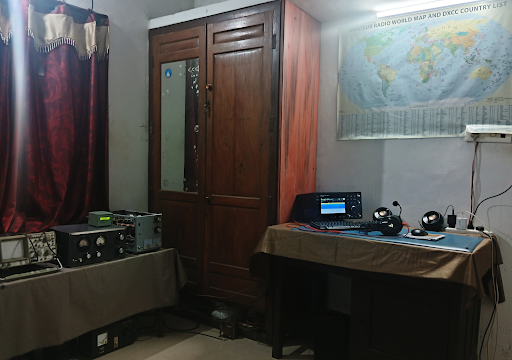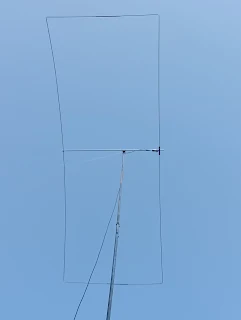Serving the worldwide community of radio-electronic homebrewers. Providing blog support to the SolderSmoke podcast: http://soldersmoke.com
Podcasting since 2005! Listen to Latest SolderSmoke
Thursday, December 11, 2025
Homebrew Radio from Southern India
Saturday, November 29, 2025
California Typewriter -- Full Movie with Tom Hanks
Wednesday, November 19, 2025
How VU2RM Got Into the Satellites
Friday, November 14, 2025
Early SSB in India: Espionage, Stolen Secrets, and Kleptomania
Monday, November 10, 2025
Puneit Singh VU2TUM's FB Homebrew 40 meter SolderSmoke Direct Conversion Receiver
Puneit is also a CW man -- we hope he pairs this receiver up with a simple CW transmitter and makes some "fully homebrew" contacts.
Sunday, June 1, 2025
Ashish N6ASD's Beautiful SolderSmoke Direct Conversion Receiver -- Built in Bangalore -- "This was such a fun project. This was my first direct conversion build, and I learned a lot along the way."
Thursday, May 29, 2025
SolderSmoke Podcast #260 FDIM, Hollow State Design, Pete's Bench and the Shelf of Shame, Direct Conversion Project News, How Best to Preserve this Blog?, Dean's Bench and the Desk of Despair, Bill's Bench and the Garage of Grief, MAILBAG
SolderSmoke Podcast #260 is available:
Audio version: http://soldersmoke.com/soldersmoke260.mp3
Video version: https://www.youtube.com/watch?v=bZzHSjOTbSY
Quote from the Old Miltary Radio Net: "Being on the leading edge is great, but sometimes being on the trailing edge is more fun." Indeed.
Heard from an Australian on the Southern Cross Net: "My antenna needs a lot of Viagra!"
News from Dayton/Xenia/FDIM: Dayton Xenia. Again, we didn't go. But Bob Crane W8SX was there and got a nice interview with Grayson, Hans, and Farhan. We are presenting these and more. Michigan Mighty Mite Revival at FDIM! Jeff W9TH.
Farhan's review of Hollow State Design: I am compelled to set aside the future of my family and to orphan my cats to resume work on the 250v power supply that I built last year. Inshallah, Allah favors those who favor thermatrons! Grayson's book is imbued with deep experimental insights and littered with gems. You have to read it over and over to find new things each time. It goes into my reference shelf in the lab." Buy it here: https://www.ermag.com/product-category/books/
PETE'S BENCH:
Pete working on JF3HZB dial. Send Pete a Heath mono-bander!
MHST on shelf of shame? Even the great ones have to take a break every so often. On the importance of taking a break. Ernest Rutherford 1917 and all that: https://soldersmoke.blogspot.com/2025/05/on-importance-of-taking-break.html
Channelized 40 meter rig. Heard in Arizona by Andy KB7ZUT on a HOMEBREW SSB Reciever. Very rare. SWL HB2HB.
Pete: Thumb broken as a Novice? Early episode of Fat Finger Syndrome?
---------------------------
Quote from N6QW: "The radios do not build themselves!"
Alan W2AEW finishes Direct Conversion Receiver. And even he worries about feedback!
Phil W1PJE MIT receiver (with cool MIT stuff). Coming to see us!
KN6FVK's Barkausen-Be-Gone Spray :https://soldersmoke.blogspot.com/2025/05/john-kn6fvks-fb-homebrew-soldersmoke.html
Indian hams working DC RX. VU2JXN Ramakrishnan, VU2TUM Puneit Singh, Ashish N5ASD, building one in Bangalore with 3D printed form from Scott, KQ4AOP. Ramakrishnan is planning on building a second receiver with his daughter. On June 22, 2008 in SolderSmoke #86 we reported on the birth of Ramakrishnan's daughter. This is that same daughter! See: https://soldersmoke.blogspot.com/2024/01/long-time-soldersmoke-supporter.html How to get a PTO form in India. A tip from Ramakrishnan: "I got the 3d printing done via https://robu.in with 1:1 size. After uploading the stl, I received it by post in 5 days or so."
German students of Andreas DL1AJG. and Canadian students of Daniel VE5DLD.
Receiver built in Singapore! 9V1/KM7ABZ
John M0XJA reports 8 members of his club are building this receiver.
Chuck N4AVC got his PTO coil form 3D printed at the local library. For free! FB!
Few admit to being fooled by April Fool story. But still, inspirational. VK3HN was going for a few seconds -- SOTA AI chatbots? John West liked the 85th harmonic threat.
-----------------------------
SHAMELESS COMMERCE DIVISION:
Check out the SolderSmoke blog on the WayBack Machine. The blog, not the podcast. www.soldersmoke.blogspot.com Would this be a useful backup if Google were to pull the plug on blogspot? Is the format OK? Is the template recoverable? How best should we backup the SolderSmoke blog?
Dean has completed his Mythbuster: https://kk4das.blogspot.com/2025/05/kk4das-mb-20-transceiver-complete.html Plexiglass top!
Diode switching.
Dean: Build of the SDR receiver. Microscope required?
____________________
BILL'S BENCH:
VK6JDW and HCJB in the Kimberly.
The stages of separation: Shack, Garage, Car trunk: HP-8640B and HAMEG scope saved from garage. HP-8640B repair. HAMEG Modulation Monitor.
=================
MAILBAG
-- Wouter ZS1KE. Thinks Soviet spies COULD homebrew. Hamilton KD0FNR concurs. Agent Sonya and Soviet Spy homebrew. Copacetic Flow. I dunno....I dunno...
-- Hamilton KD0FNR grew up in New Mexico, supports my idea of Starlink deorbit. See : https://www.kallmorris.com/columns/goodness-gracious-green-balls-of-fire
-- Adam N0ZIB Heard my 10 meter beacon from the DR. 28,233.5 MHz On now.
-- Rick N3FJZ Great memory Direct Conversion messages.
-- John KN6FVK had fun with DC RX. Tattoos on Board. We need a high sign! Like the Little Rascals.
-- Adrian M7EFO DC RX builder in GQRP. FB.
-- Steve KW4H Kits not the same as homebrew, but old Boatanchor kits have value.
-- Mike WU2D -- Old buddy Charles Kitchen SK.
-- Craig -- Some really nice feedback on Hack-A-Day re DC RX and Dean's videos.
-- Peter VK3TPM proposes a certificate for SolderSmoke DC RX Honor Roll.
-- Michael WN2A used a 3 inch reflector from Northern New Jersey. Edmunds Scientific "Space Conqueror"
-- Phil W1PJE and Mike WN2A lament that our eyes don't pick up radio frequencies. This would be a great troubleshooting tool! I can SEE the IMD! Perhaps some tin foil hats?
-- John WPE9IRS SW listener! Heard my beacon. Many SWLs switching to tuning in ham stations.
-- Peter VK3YE found a homebrew 160 meter double-sideband transciever at a hamfest. He also found "Solid State Basics for the Radio Amateur -- A QST Anthology" NOT SSDRA. But good!
-- Peter VK2EMU From the Southern Cross (I took a picture of it in the DR!) Building the DC RX!
Friday, May 9, 2025
Ramakrishnan VU2JXN's FB SolderSmoke Direct Conversion Receiver: "Extremely thrilled! Hooked!"
This is a really important Hall of Fame entry for us. This is our first completed SolderSmoke Direct Conversion Receiver from India (more will come).
Most importantly, this receiver was built by our good friend Ramakrishnan VU2JXN (ex VU3RDD). Ramakrishnan goes way back in SolderSmoke history. He was the one who first suggested (in 2006!) that our podcast needed a blog to go with it. This was the origin of the SolderSmoke Daily News. A short time later we announced the birth of Ramakrishnan's daughter. That same daughter now has her ham license and will build a second receiver with her dad.
The roots of this receiver are deep in India. When Dean and I first went to the local high school to talk about ham radio support, I carried with me a Direct Conversion Receiver inspired by Farhan VU2ESE. In fact, that receiver had a picture of Farhan and quotes from him taped to the wooden base. When Dean and I designed the receiver that we tried to build with the High School kids, we used an oscillator based on the DC receiver that Farhan was building with youngsters at Indian girl's schools. That is the receiver design that we are using in this SolderSmoke Challenge.
Ramakrishnan is in Bangalore now, which is where he built this receiver. Ashish N6ASD is also there now, and is building a receiver.
Ramakrishnan writes:
Needless to say, you folks convinced me to get back into homebrew
and you have hooked me into it with this project.
Again, couldn't turn off from it even though I am at work! The bug has
caught me.
Join the discussion - SolderSmoke Discord Server:
Documentation on Hackaday:
https://hackaday.io/project/
SolderSmoke YouTube channel:
Tuesday, January 14, 2025
Shock and Awe: The Story of Electricity --- Wonderful Video by Jim Al-Khalili (sent to us by Ashish N6ASD)
Jim talks about the early transatlantic cables, and why some of them didn't work.
We see Jagadish Chandra Bose developing early point-contact semiconductors (because the iron filings of coherers tended to rust in the humid climate of Calcutta!)
There is a video of Oliver Lodge making a speech. There is a flip card video of William Crookes (one of the inventors of the cathode ray tube and the originator of the Crooke's cross).
We see actual coherers.
There is simply too much in this video for me to adequately summarize here. Watch the series. Watch it in chunks if you must. But watch it. It is really great.
Thanks Ashish. And thanks to Jim Al-Khalili.
Tuesday, June 25, 2024
Field Day with Farhan, his Family and an sBITX Near Hyderabad, India
Farhan and his son Rayyan with an sBITX
The SolderSmoke crew thought it had a tough time this Field Day: Pete N6QW had hoped to do something, but was stymied by hot California weather. Dean KK4DAS had even worse weather. Bill HI7/N2CQR was at a remote QTH with an HW-8 and a wire antenna -- he managed just ONE contact (W7RN in Nevada on 15 CW). But none of us had as much trouble as our friend Farhan had. In his account of Field Day in Hyderabad, we see an intrepid ham standing up against the slings and arrows of outrageous fortune that Field Day often throws at true radio amateurs. Here is Farhan's Field Day story:
-----------------------------
You asked for it, so here it goes...
Thursday, March 7, 2024
The Wizard of Schenectady -- Charles Proteus Steinmetz
Such a beautiful article. Ramakrishnan VU2JXN sent it to me. It reminded me of how puzzeled we were when we found "Schenectady" on old shortwave receiver dials, amidst truly exotic locations. Rangoon! Peking! Cape Town! Schenectady? Obviously this was due to General Electric's location in that New York State city. But reading this article, I am thinking that the presence of Charles Proteus Steinmetz had something to do with it. His informal title (The Wizard of Schenectady) confirmed that we have been right in awarding similar titles to impressive homebrewers.
Here is the Smithsonian article that Ramakrishnan sent.
And here is a link to a PBS video on Steinmetz:
https://www.pbs.org/video/wmht-specials-divine-discontent-charles-proteus-steinmetz/
Here is a SolderSmoke blog post about "Radio Schenectady":
https://soldersmoke.blogspot.com/2020/07/radio-schenectady.html
Tuesday, January 2, 2024
Long-time SolderSmoke supporter Ramakrishnan VU2JXN Interviewed on QSO Today
Friday, December 15, 2023
Check out the Hyderabad, India Hamfest! LARC-6
Thursday, December 14, 2023
Mythbuster Video for the Lamakaan Amateur Radio Club of Hyderabad, India
Saturday, December 2, 2023
"My Radio My Life" A Film about Radio Enthusiasts
My Radio My Life | Trailer | 4K from Makarand Waikar on Vimeo.
Wow! VU2DTR is presenting a film about radio made by her mom VU2RBI. They are showing it in Bethesda, Maryland today.
Trailer above, summary below: This looks really great. I hope we can see the whole film on-line soon!
--------------------------------------------
Set in the 21st century, the film revisits the golden era of radio in, when it was the dominant, popular, and only source of entertainment, news, and knowledge.
Being a medium that is heard across national borders, the radio has been instrumental in expanding horizons and enriching the lives of generations. Besides giving companionship to individuals, the radio brought families together and inspired people to make life choices.
Radio continues to enthrall people with its evolving nature and the sentiments associated with it.
Wednesday, October 11, 2023
Sunburst and Luminary: Apollo "Rope" Memory, and other items of interest
Wow. That is the method that they stored computer memory for the moon missions. When they were satisfied with a program they would say it was time to "put it on the rope."
Here's an article on the women who built the rope memory (and the integrated circuits used in Apollo). This reminded me of the women's collective in Hyderabad that "wove" the ferrite core transformers for Farhan's BITX rigs:
Here is a Wikipedia article on core rope ROM memory with some great illustrations:
https://en.wikipedia.org/wiki/Core_rope_memory
-- Not long before the fatal Apollo 1 fire, an MIT colleague of Don Eyles had a drink with Astronaut Gus Grissom. Grissom unloaded about the poor state of the spacecraft, saying that, "What we have here is a Heathkit." Grissom died in the fire.
-- Eyles mentions the use of 6L6 tubes in analog audio amplifiers.
-- MIT's Doc Draper used a Minox camera.
-- When the Apollo 11 astronauts came back and were living for two weeks in an isolation chamber, NASA had bulldozers on standby to bury the whole thing ("astronauts, staff and all") in case some dangerous moon bug was detected. (Is that true?)
-- At one point soon before an important missile test, engineers realized that they needed an isolation transformer. They did not have enough time to order one. So they took an isolation transformer out of one of their soldering stations and used it in the missile. It worked. Sometimes you just use what you have on hand.
Friday, September 15, 2023
HB2HB -- A Contact with Denny VU2DGR (video)
At first I didn't realize it was Denny. On September 11, 2023 at about 2330Z I had walked back into the shack after dinner. I think DX spots showed an Indian station on 20 meter SSB. Without realizing who it was, I tuned him in on my Mythbuster rig, heard the other station sign off, and quickly threw in my call. Denny came back to me right away, and I think both of us then realized that we recognized the call of the other station. Wow, it was Denny, VU2DGR, the Wizard of Kerala! At the time of the QSO, I didn't have my phone with me; after we spoke, I went to get it, so the video above captures part of Denny's subsequent contact. (You can also at one point hear Guapo barking.)
Denny has been running a wonderful station that combines SDR gear with and HDR tube type amplifier and a homebrew Moxon.
Here is Denny's station. The transceiver is a RadioBerry. the amplifier and power supply are on the other table.























